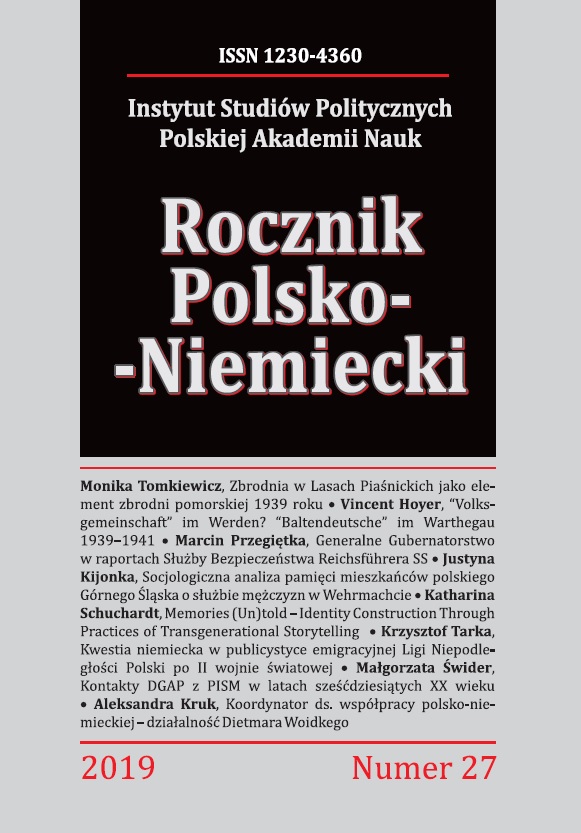Zbrodnia w Lasach Piaśnickich jako element zbrodni pomorskiej 1939 roku
The Massacre in the Piaśnica Forests as an Element of the Pomeranian Crime of 1939
Author(s): Monika TomkiewiczSubject(s): Social Sciences, Political history, Social history, Recent History (1900 till today)
Published by: Instytut Studiów Politycznych PAN
Keywords: the Pomeranian Crime of 1939; Volksdeutscher Selbstschutz; ‘Intelligenzaktion’; ‘Säuberungsaktion’; exhumation; massacre in the Piaśnica forests; Albert Forster; Richard Hilderbrandt
Summary/Abstract: The term ‘Pomeranian Crime of 1939’ means acts of direct extermination carried out on the Polish population from September 1939 to the first months of 1940 by the Volksdeutscher Selbstschutz, Wehrmacht and SS divisions. It was a planned and mass campaign carried out in over 400 towns located in the pre-war Pomeranian province. This action involved capturing and arresting Poles, and selecting people to be shot from among this group. The massacre in the Piaśnica forests was the first and largest crime in Pomerania and, at the same time, one of the first on such a large scale in Europe. The executions in the Piaśnica forests began in late October 1939 and lasted until the first months of 1940. In November and December 1939, approximately 2,000 Poles and Jews from Gdynia, Wejherowo and Puck, as well as the Kartuzy and Gdańsk poviats were shot. People brought by rail from the Third Reich also died in Piaśnica. Among them were mentally ill people, opponents of Hitlerite ideology and Poles living in Germany before the war. The massacre in the Piaśnica forests was also supervised by Friedrich Class, the head of the Gdynia Gestapo, and SS-Brigadeführer Christoph Diehm, the head of the Gdynia police. SS officers from Wachsturmbann ‘Eimann’ and members of the local Volksdeutscher Selbstschutz under the supervision of the Gdynia police and the Gestapo dealt with escorting the victims to the place of execution and the execution. The bodies of those murdered in Piaśnica were buried in 35 mass graves. At the end of August 1944, the Germans began to remove traces of the executions carried out in Pomerania. In 1946, a special exhumation commission was established on the initiative of the members of the Polish Western Association in Wejherowo to determine the number of victims murdered in Piaśnica and identify unburnt corpses. On 2 April 1967, prosecutor Marian Multan issued a decision to initiate an investigation with the reference number Ds. 1/67 regarding the murder of approximately 12,000 Poles in the Piaśnica forests in the Wejherowo poviat from September to December 1939. This investigation was suspended by the Polish side on 20 September 1975 due to the impossibility of interrogating witnesses and suspects living in the West. After the end of the war, several criminal trials were carried out in Germany and Poland in which ‘the executioners from Piaśnica’ sat in the dock. In 2011, prosecutor Maciej Schulz, the then Head of the Departmental Commission for the Prosecution of Crimes against the Polish Nation in Gdańsk, reinitiated this investigation and it continues to this day. Polish researchers estimate the number of victims of the Piaśnica massacre at 12,000 to 14,000, while the Germans estimate it at about 6,000. The investigation conducted since 2011 at the Branch Commission in Gdańsk will verify this data. Numerous studies carried out in Polish and German archives have made it possible to obtain many valuable documents that significantly broaden our knowledge of this crime scene. To date, it has been possible to determine approximately 1,300 names of executed Poles and approximately 1,200 mentally ill persons transported from Germany.
Journal: Rocznik Polsko-Niemiecki / Deutsch-Polnisches Jahrbuch
- Issue Year: 2019
- Issue No: 27
- Page Range: 11-29
- Page Count: 19
- Language: Polish

